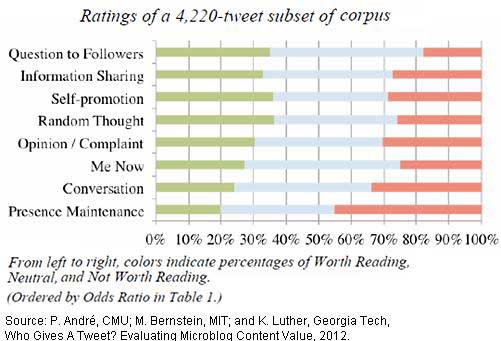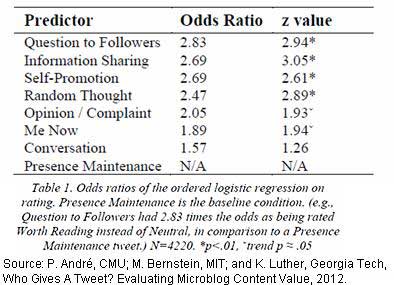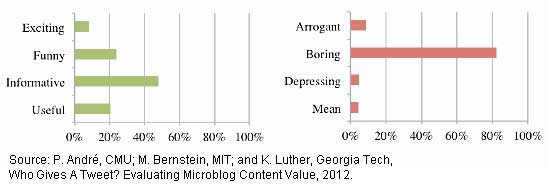Twitter users* say only 36% of the tweets they receive are worth reading, 39% are mediocre at best, and 25% of tweets are not worth reading at all, according to a study by researchers at Carnegie Mellon University, MIT, and Georgia Tech.
The findings are based on a survey of 1,443 Twitter users who rated 43,738 tweets during a 19-day period (Dec. 30, 2010 to Jan. 17, 2011) from the accounts of some 21,014 Twitter users they collectively followed. The research was facilitated by the site "Who Gives a Tweet?"**
Among those surveyed, Twitter content was deemed "not worth reading" for various reasons. Tweets that were part of someone else's conversation, or updates around a current mood or activity, were the most strongly disliked, whereas tweets that included questions to followers, information sharing, and self-promotion (such as links to content the writer had created) were liked more often.
Below, additional findings from the study titled "Who Gives a Tweet? Evaluating Microblog Content Value," conducted by Paul André, post-doctoral fellow in Carnegie Mellon's Human-Computer Interaction Institute, with Michael Bernstein and Kurt Luther, doctoral students at MIT and Georgia Tech, respectively.
Among all types of tweets analyzed, "Presence Maintenance" tweets (e.g., "Hullo twitter!") were the most strongly disliked, registering a 45% probability of being Not Worth Reading (NotWR), compared with 18% for "Question to Followers" tweets.
Presence Maintenance communications were generally considered "content-less," among those surveyed, eliciting comments such as "I have one word for one word tweets: BORING", or "useless."
The following chart shows various tweet types and respondents' attitudes toward them:

"Conversational" tweets and "Me Now" tweets (current mood or activity updates) were also strongly disliked.
In the table, Presence Maintenance is the baseline condition. For example, Question to Followers tweets were 2.83 times more likely to be rated Worth Reading (WR) instead of Neutral, compared with a Presence Maintenance tweet:

Twitter reviewers were asked to rate individual tweets as WR or Not WR; they could also qualify their rating with one of the following eight reasons: arrogant, boring, depressing, mean, funny, exciting, useful, or informative.
Being boring was a far more prevalent problem among tweets evaluated.
Among 17,557 ratings tagged with a reason, tweets that were informative (48%) and funny (24%) were most likely to be rated WR (green chart on left), whereas tweets that were boring were most likely to be rated NotWR (82%).

Boring tweets rated NotWR tended to repeat old news, were often cryptic, or used too many # and @ signs, according to study. Boredom was also associated with banal or prosaic tweets, leading to responses such as "and so what?" or "it's fine, but a bit obvious."
Key Takeaways
Below, the researchers' recommendations for improving tweet content based on the evaluations returned:
- Old news is no news: Information rapidly gets stale on Twitter. Followers quickly get bored of links seen multiple times.
- Provide context: Tweets that are too cryptic leave readers unable to understand their meaning. Simply linking to a blog or photo, without giving readers a reason to click on it, was described as "lame."
- Limit Twitter-specific syntax: Overusing #hashtags, @mentions, and abbreviations makes tweets hard to read. Some syntax is helpful: if posing a question, adding a hashtag helps everyone follow along.
- Keep it to yourself: The clichéd "sandwich" tweets (e.g., "what I'm eating") about pedestrian, personal details were largely disliked. Reviewers reserved a special hatred for Foursquare location check-ins.
- Don't whine: Negative sentiments and complaints were hugely disliked.
- Keep it short: Twitter limits tweets to 140 characters, but followers still appreciate conciseness. Using as few characters as possible also leaves room for longer, more satisfying comments on retweets.
- Go professional: People* may often follow you to read professional insights and can be put off by personal gossip or everyday details.
*Note on respondents: Many users to the site "Who Gives a Tweet?" were referred by technology-focused and business websites (e.g., TechCrunch, Mashable, and CNN), as well as a link distributed via Twitter. Though the survey sample size was substantial, the demographic of respondents is likely skewed toward those who visit such sites.
**Twitter users who visited the site were promised feedback on their tweets if they agreed to anonymously rate tweets by Twitter users they already were following.
About the data: The analysis is based on data from December 30, 2010 to January 17, 2011. Some 1,443 visitors to the study's site rated 43,738 tweets from the accounts of 21,014 Twitter users they followed.



